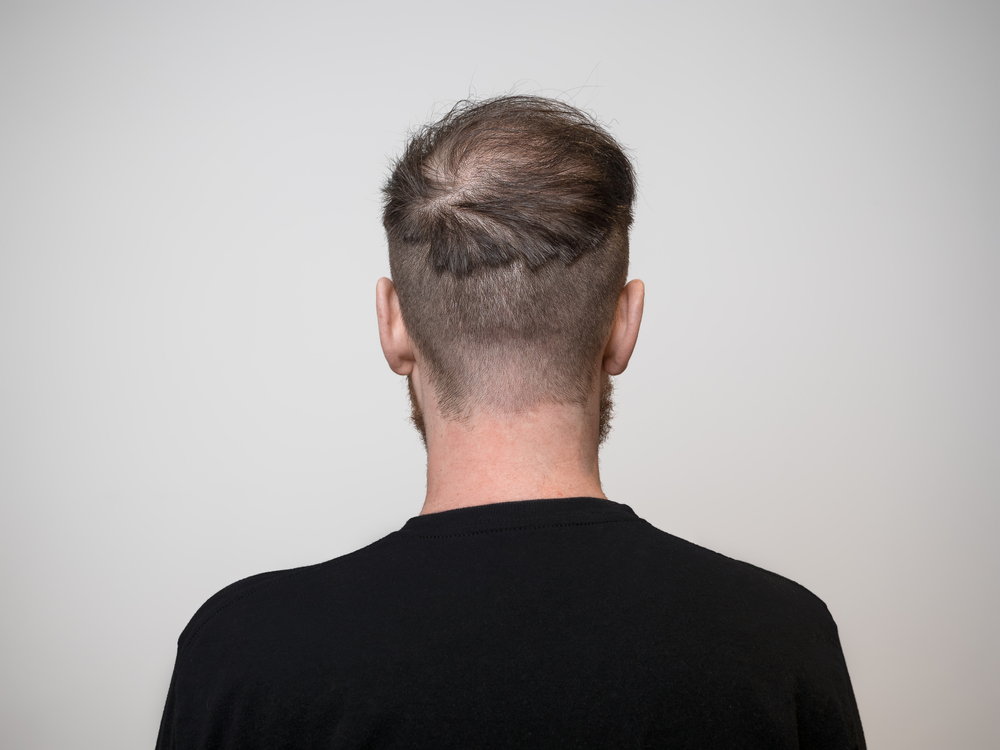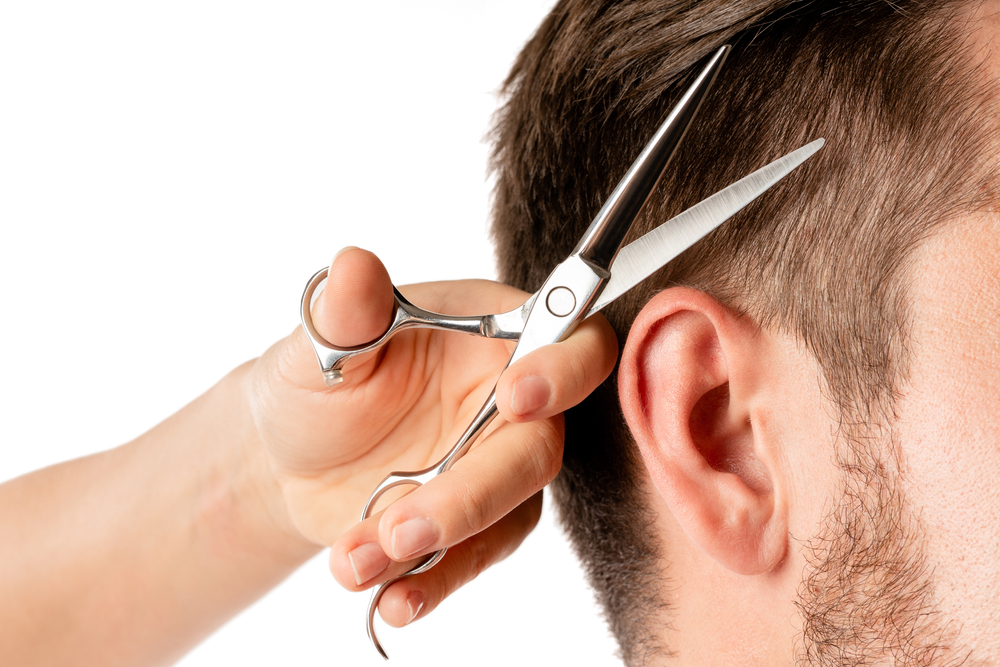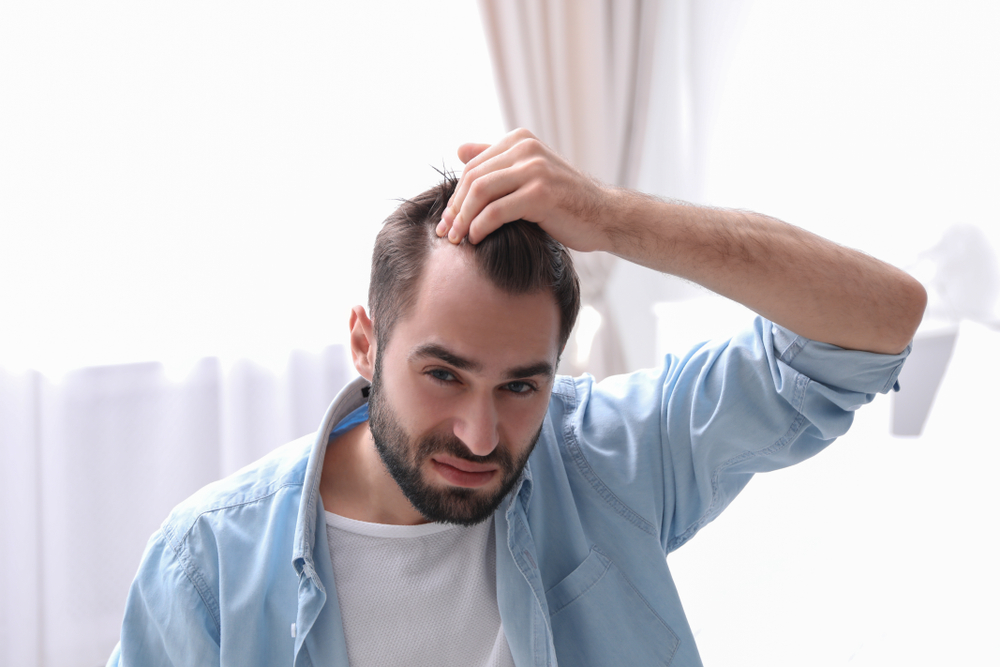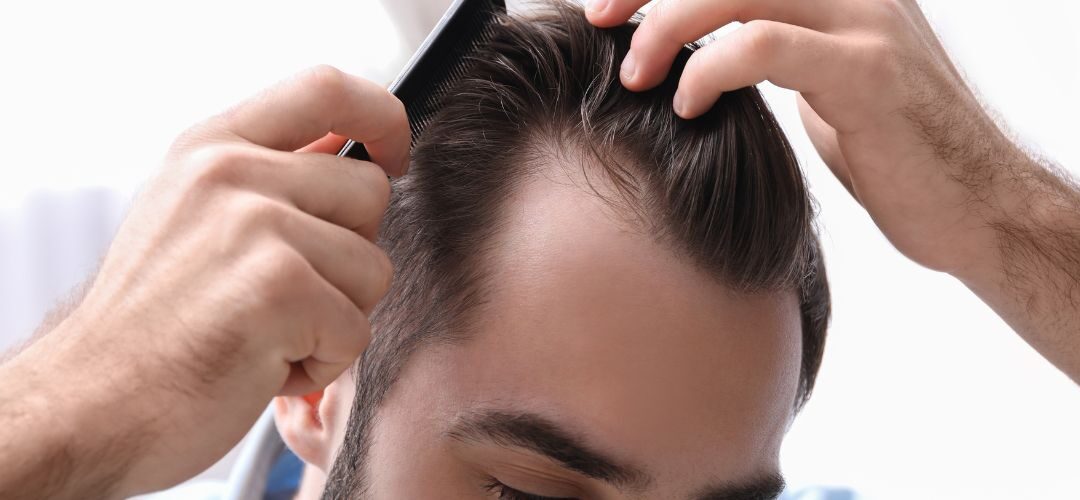If you’ve noticed the first signs of a receding hairline, worry not, as there are a number of promising treatments on the market to promote healthier hair and reduce further hair shedding.
Throughout their lifetime, approximately 42% of men will experience moderate to severe hair loss. In many cases, this hair loss occurs as a result of male pattern baldness (MPB).
Discovering that you have a receding hairline can be a distressing experience, but we’re here to help you to discover the most effective treatments to keep your hair feeling fuller for longer.
Early warning signs for hair loss
Extreme hair loss, in the form of a receding hairline, does not happen overnight. The best way to minimise the effects of androgenetic alopecia (aka male pattern baldness) is to be aware of the early signs of hair loss, so that you can seek treatment while you still have most of your hair.
Thinning hair
If you’ve noticed an increase in the amount of hair loss when you’re brushing or styling, this could be an initial warning sign of further hair thinning to come. For those men who have longer hair, it’s a good idea to gently pull back your hair, away from your forehead, to see if you have an signs of a receding hairline. In many cases, longer hair can mask the early signs of androgenetic alopecia, so it’s good to take a long look in the mirror every now and then.
Receding hairline
While some forms of temporary hair loss may grow back in the future, unfortunately it’s unlikely that you will be able to reverse hair loss caused by a receding hairline. As a receding hairline is often one of the first signs of future hair loss to come, it’s important to take action when you notice any thinning hair on this area of the scalp.

The more hair you have when you begin your hair loss treatment, the more likely you are to maintain and nourish your remaining hair follicles.
Male pattern baldness
Visible hair loss that appears as a receding hairline or bald spot on the top of the scalp can usually be attributed to male pattern hair loss, also known as androgenetic alopecia.
Both men and women experience pattern hair loss, most commonly as a result of a family history or genetic make up. While men see this type of hair loss in the form of a receding hairline or bald patch, visible signs in women can often be seen through reduced hair density across the entire scalp.
How to reduce male pattern baldness appearance
Although it is not possible to regrow hair lost as a result of male pattern baldness, there are a number of techniques that both men and women can use to reduce the visible signs and nourish the remaining hair follicles.

Moisturising your scalp tissue with soothing agents, such as aloe vera, can also assist in reducing the amount of hair loss you experience. A scalp massage with nourishing properties may also nurture the lifecycle of hair follicles, through increased blood flow beneath the surface of the scalp.
In combination with prescription medication and topical minoxidil, you may be able to achieve the look of a thick head of hair, by simply talking to your barber about a new style that minimises the visibility of a receding hairline.
Other factors for hair loss and receding hairlines
While male pattern hair loss is the most common cause of a receding hairline, gradual hair loss can occur due to a number of outside influences and lifestyle factors.
Although new hair growth cannot be achieved by men and women with pattern hair loss, there are other types of temporary loss that allow for the possibility of hair regrowth. The first step in dealing with hair loss is talking to your healthcare provider to identify the cause behind your receding hairline.
Frontal fibrosing alopecia
As with a receding hairline caused by MPB, frontal fibrosing alopecia appears when a significant amount of hair follicles are lost from the front of the scalp. Unlike androgenetic alopecia, however, frontal fibrosing alopecia is a rare disorder that can be attributed to hormonal changes or an autoimmune response.

Hair loss caused by this condition occurs gradually, with some patients also losing facial hair, such as eyebrows and eyelashes. Due to the severity of this condition and the shared similarities of initial onset seen in MPB, it is crucial to address an early warning signs of a receding hairline.
Telogen effluvium
If the growth cycle of a hair follicle is interrupted due to stress or trauma, hair loss can occur. People who experience telogen effluvium are likely to be able to grow hair in the future, after the underlying stress or trauma has been resolved.
Toxic signs causing alopecia
While many people associate hair loss (alopecia) with medical conditions or family history, there are also a number of toxic agents that have been linked to impeded hair growth. Research shows that mercury, selenium, colchicine and thallium have all been linked as causes of alopecia.
Underlying health conditions
Hair health can be affected by a number of influences, including underlying medical conditions. In these cases, the growth of hair follicles may be affected by either the disorder itself or the prescribed medication for treatment of the condition.
Harsh chemicals, such as those used in chemotherapy drugs, can cause hair loss. Other medical conditions, including fungal infection, high fever, bacterial infection insomnia or an immune disorder, can all impact the growth factors of hair follicles, resulting in hair loss.
Promote hair growth and prevent further hair loss
Along with identifying the early signs of a receding hairline and medical treatment options, there are a number of simple ways to promote healthy hair, including:
-
Avoid tight hairstyles
-
Eat a healthy diet
-
Scalp massage
-
Healthy lifestyle choices
-
Invest in quality hair care
Receding hair loss treatment options
With around 42% of all men experiencing moderate to severe hair loss throughout their lives, you can assume that a great deal of medical research has been conducted, to develop a number of highly effective hair loss treatments.
Whether you’re interested in surgical options like hair transplantation, searching for some natural remedies or want to know about prescription drug options for hair loss treatments, let’s discover what’s out there.
Naturally stimulating hair growth
While there is not cure for receding hairlines caused by male pattern baldness (androgenic alopecia), there are a number of natural ways to promote healthy hair, while reducing the likelihood of continued hair thinning in the future.
A scalp massage can encourage hair growth, by stimulating and increasing blood circulation across the top of the head. Healthy habits, such as this, not only feel great but can healthy hair growth and the nourishment of existing hair follicles.

Certain essential oils also offer hair growth promoting effects, including aloe vera extract, lavender oil and peppermint oil.
Hair transplants and platelet rich plasma
Platelet rich plasma injections are one of the more invasive forms of treating hair loss, but have proven to be effective in treating male pattern baldness, including a receding hairline. These injections may prevent further hair loss and can also stimulate hair growth.
A hair transplant is one surgical option whereby hair is grafted to existing follicles. While there have been some successful results achieved by hair transplant patients, the outcome is highly dependent upon the amount and condition of existing hair follicles.
Prior to choosing one of the more invasive methods for treating hair loss, most doctors will recommend non-invasive solutions, such as oral medications or topical creams to treat a receding hairline.
Prescription treatment
There are many prescribed options available to treat hair loss, however research shows a highly effective response to oral finasteride in many men. Oral finasteride is known as an enzyme blocker, which alters testosterone levels to increase hair growth on the scalp.

Topical treatments
Non-prescription medication is often used in conjunction with prescription medication. As a non-invasive treatment, it is often recommended by health care professionals. Prior to application of the solution, patients may also opt to partake in response testing, which provides evidence of the viability of the treatment, from analysis of just a few strands of hair.
Peer reviewed studies have shown that one of the most effective ways to treat hair loss is through a combination of prescription and non-prescription medications.
Let’s get your health sorted!
If you’re experiencing hairline recession, the best course of action is to start a conversation with a doctor and seek professional medical advice. Understanding the type of hair loss you’re dealing with will allow you discover a treatment that’s right for you.
Sources
GARD. (2021) Frontal fibrosing alopecia. (https://rarediseases.info.nih.gov/diseases/10886/frontal-fibrosing-alopecia)
Johns Hopkins Medicine. (2022) Platelet rich plasma (PRP) Injections. (https://www.hopkinsmedicine.org/health/treatment-tests-and-therapies/plateletrich-plasma-prp-treatment)
Karger. (2018) Alopecia and associated toxic signs: A systematic review. (https://www.karger.com/Article/)
NIH. (2014) Clinical utility and validity of minoxidil response testing in androgenetic alopecia. (https://pubmed.ncbi.nlm.nih.gov/25112173/)
